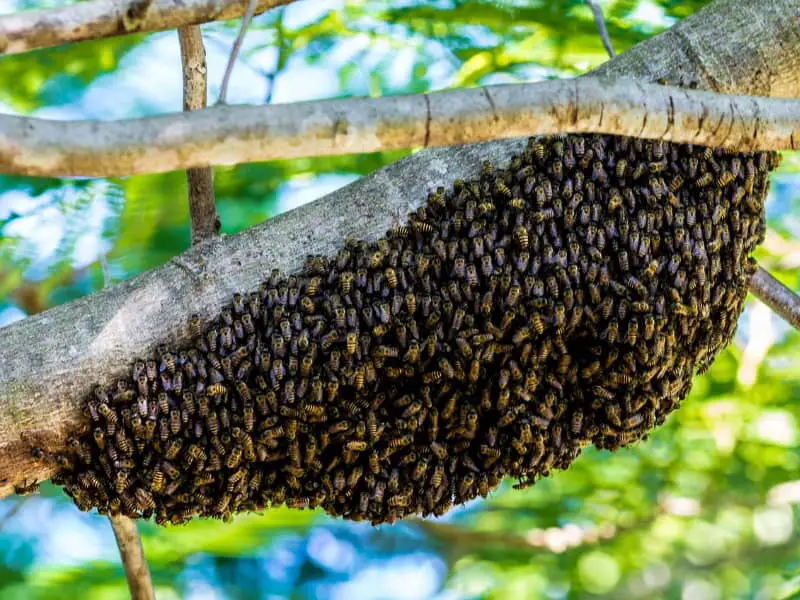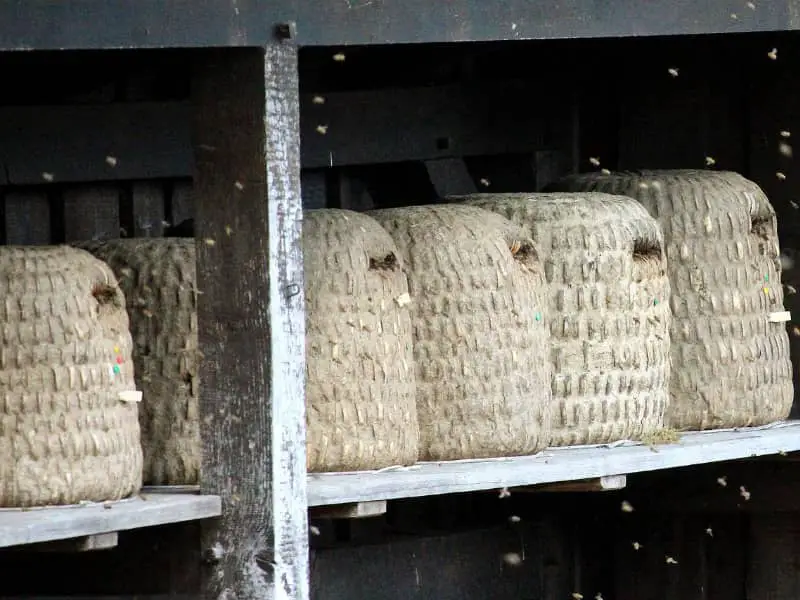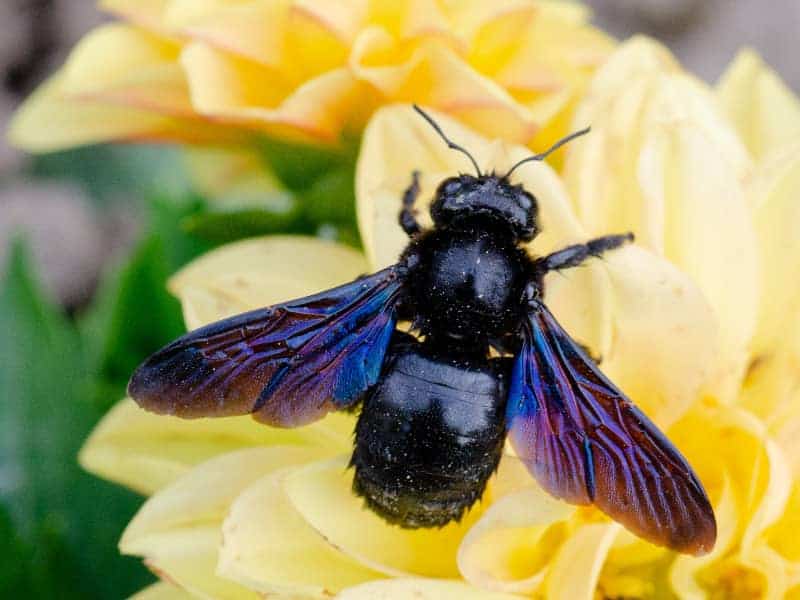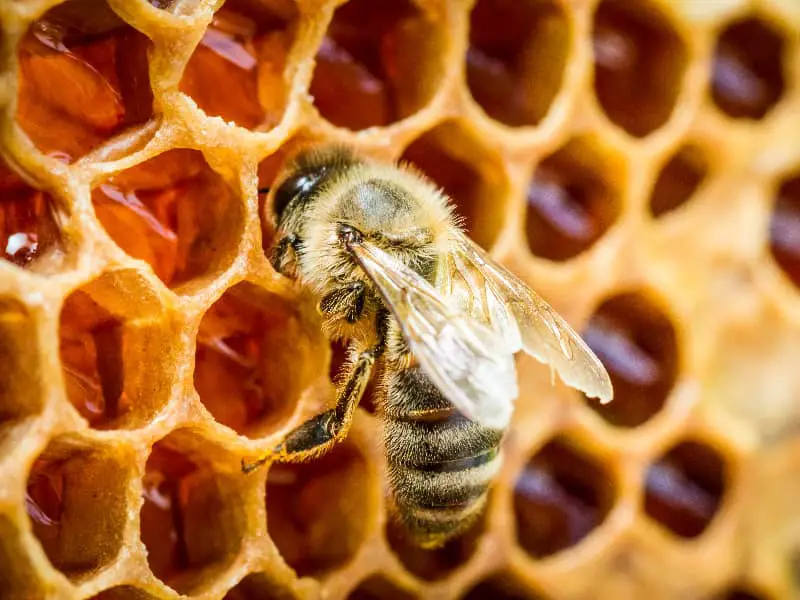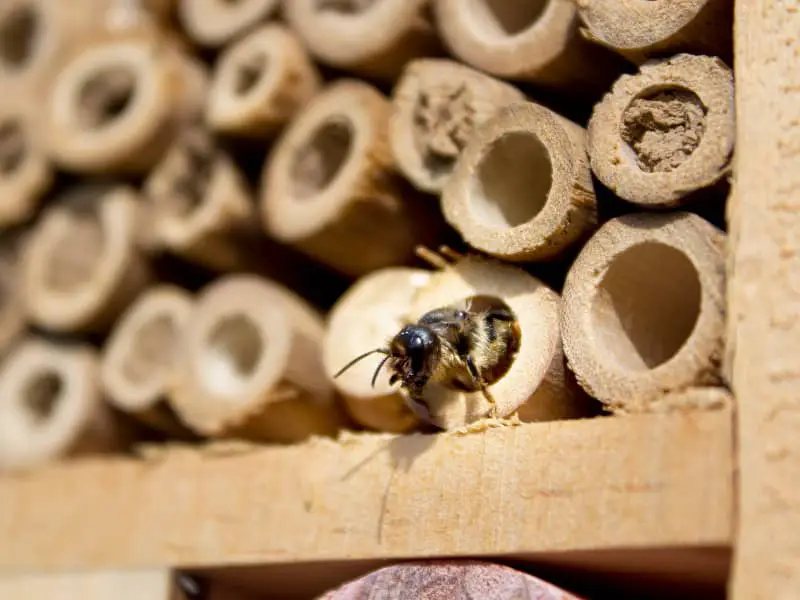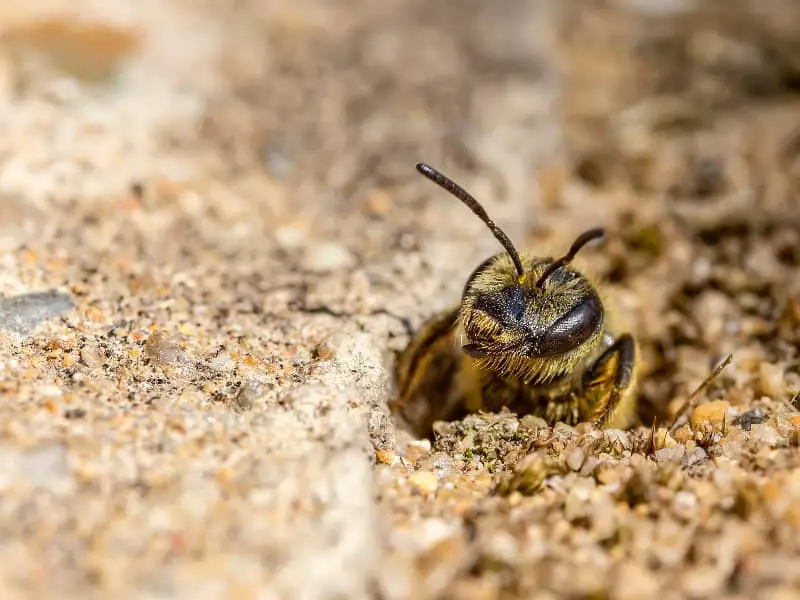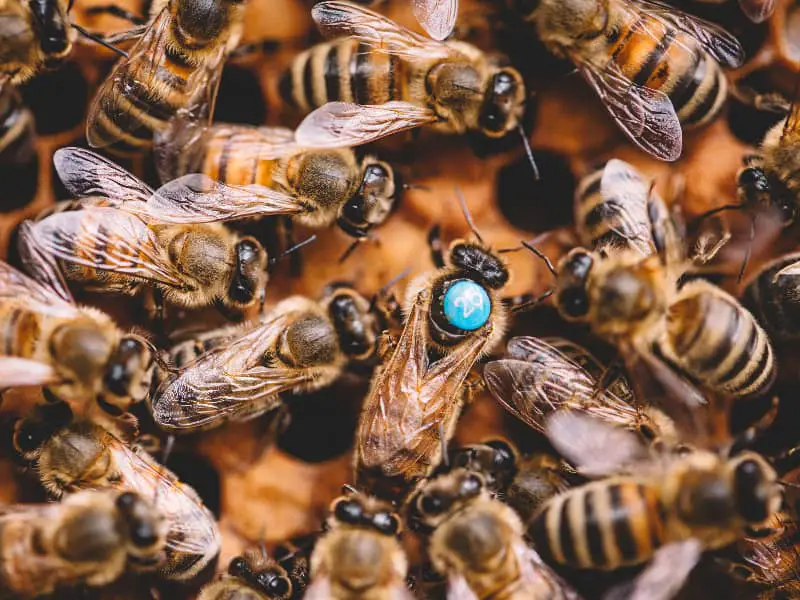
Reproduction of bees
For many of us, the buzzing of bees is a familiar sound, heralding the beginning of spring and the scent of blooming flowers. But behind this seemingly simple scenario lies a complex world of bee reproduction that is essential to the survival of bees and the health of our ecosystems.
In this article, we dive deep into the fascinating topic of bee reproduction and explore how this process works, what roles queen, drones and workers play and why it's all so important to us.
- Reproduction of bees
- Importance of bees for ecosystems
- Basics of bee anatomy
- Species of bees and their reproductive trajectories
- Social structure in the hive
- Role of the queen in the reproduction of bees
- Reproduction of bees - the role of drones
- Reproduction of bees - the workers
- Reproduction of bees - The mating flight
- Reproduction of bees, why swarming?
- Reproduction of bees in different seasons
- Reproduction of bees - threats and challenges
- Conclusion: reproduction of bees
Importance of bees for ecosystems
Bees are not only responsible for the production of honey, but also play a crucial role in the pollination of plants. In fact, about 80 % of pollination in nature is due to bees. Through their work, they not only support food production, but also contribute to the conservation of biodiversity.
Bee reproduction is therefore a key process that goes far beyond the production of honey and is important for the functioning of the entire ecosystem.
Importance of reproduction
The complex system of bee reproduction is a perfect example of evolution. Every part of this process is designed to ensure the survival of the hive and the species as a whole. Reproduction occurs through a clear division of tasks between the queen, the drones and the workers. This ensures that the hive remains vital and can adapt to changing environmental conditions.
Aim of the article
The focus of this article is to provide a comprehensive understanding of the reproductive process of bees. From the biological basics to the current challenges posed by parasites and climate change, we will look at all aspects in detail. In doing so, we will pick up on current research findings and also provide practical tips for beekeepers to promote the health and reproductive capacity of their bee colonies.
Basics of bee anatomy
The bee's anatomy is a marvel of evolution, adapted to its respective roles in the ecosystem and within the hive. This is especially the case in relation to reproduction. So let's get into the anatomical features of bees that are relevant to reproduction.
Gender differences
Bees differ not only in size and color, but also in their anatomical structure according to sex. While the queen is essentially responsible for egg laying, the drones have the task of mating with the queen. The queen has a special laying apparatus called a laying spine.
Drones, on the other hand, have no visible anatomical structures for hive work, such as a stinger, since their main function is reproduction.
Reproductive organs
In the world of bees, the reproductive organs are highly specialized for the tasks they must perform. The queen has a so-called spermatheca, a container in which the sperm of the drones is stored after mating.
The drones are equipped with a so-called endophallus, an organ responsible for the transfer of sperm during mating. It is impressive how precisely these organs are formed for the reproductive process.
Life cycle
The life cycle of bees is strongly linked to their reproduction. From egg laying to adult insect, bees go through different stages: egg, larva, pupa and finally the adult insect. The duration of these stages can vary depending on the role in the hive and environmental conditions. For example, a queen lives for several years, while drones live only a few weeks, as their only task is mating.
Species of bees and their reproductive trajectories
Although most people immediately think of honeybees when it comes to bees, there are a variety of bee species. Each has its own unique reproductive strategies and methods. In this section, we highlight the reproduction of some of the most well-known bee species: honey bees, wild bees, and bumblebees.
Honey bees
Honeybee reproduction is probably the most thoroughly researched and understood among bee species. In a honeybee hive there is exactly one queen, who is responsible for egg laying. After a mating flight, during which she ingests the sperm of several drones, she is able to lay eggs for the rest of her life. The workers are sterile females that mainly take care of the brood and the maintenance of the hive.
Wild bees
Unlike honey bees, many wild bees live as solitary bees rather than in collective hives. These solitary bees each have their own nest sites and lay their eggs individually in nest chambers. Here, a mixture of pollen and nectar is often deposited as food for the larvae. Reproductive cycles can also vary, from once a year to several times in a season.
Bumblebees
Bumblebees are closely related to honeybees, but have some differences in their reproductive behavior. For example, in bumblebees, only the queen survives the winter to establish a new hive in the spring. Their first offspring are exclusively workers, who expand the hive and produce the next generation of queens and drones later in the year.
Social structure in the hive
A hive is a perfectly organized social structure composed of different roles to ensure the survival and reproduction of the colony. In this section, we focus on the three main actors in the social structure of a hive: the queen, the workers and the drones.
Queen
The queen is the heart of the hive and plays a crucial role in reproduction. She is the only fertile female and thus responsible for egg laying. After a successful mating flight, she stores the sperm in her spermatheca and is then able to lay eggs for the rest of her life, which can last several years. The queen is especially cared for by the workers, being fed a special food called royal jelly, which promotes her fertility.
Workers
Workers are the sterile females in the hive and make up the majority of the population. They are responsible for a variety of tasks, including queen care, brood care, food procurement, and hive defense. Although they are not directly involved in reproduction, they play a critical role in rearing the next generation and providing for the queen so that she can continue to lay eggs.
Drones
Drones are the only male bees in the hive and have only one task: mating with a queen. They are grown by the queen from unfertilized eggs and live only a few weeks. Once they have mated with a queen, they die. Drones have no stingers and do not participate in other hive activities such as food gathering or defense.
Role of the queen in the reproduction of bees
The queen is indisputably the most important player in reproduction in the hive. Her tasks go far beyond the mere laying of eggs. She is responsible for genetic diversity and thus for the health of the entire colony. In this section, we look at the queen's mating flight, egg-laying and life span to gain an in-depth insight into her role in bee reproduction.
Mating flight
The mating flight is a unique and critical event in the life of a young queen. She leaves the hive, often accompanied by a small group of workers, and flies to a so-called drone collection site. Here she meets drones of different strains and mates with several of them. The sperm collected is stored in her spermatheca and is sufficient for the entire duration of her egg laying. This process also contributes to the genetic diversity of the colony.
Egg laying
After the mating flight, the queen returns to the hive and starts laying eggs. She can lay both fertilized and unfertilized eggs. Fertilized eggs develop into workers and eventually new queens, while unfertilized eggs develop into drones. The queen lays between 1,000 and 2,000 eggs per day, depending on demand and season.
Lifespan
The life span of a queen bee is surprisingly long compared to other members of the hive. While workers and drones live only a few weeks to months, the queen's lifespan can be several years. Her longevity enables her to ensure the reproduction of the colony over longer periods of time.
The queen is the center of reproductive activity in the hive and her role is complex and multifaceted. Her contribution to genetic diversity, egg laying and colony longevity is crucial for the survival of the bees.
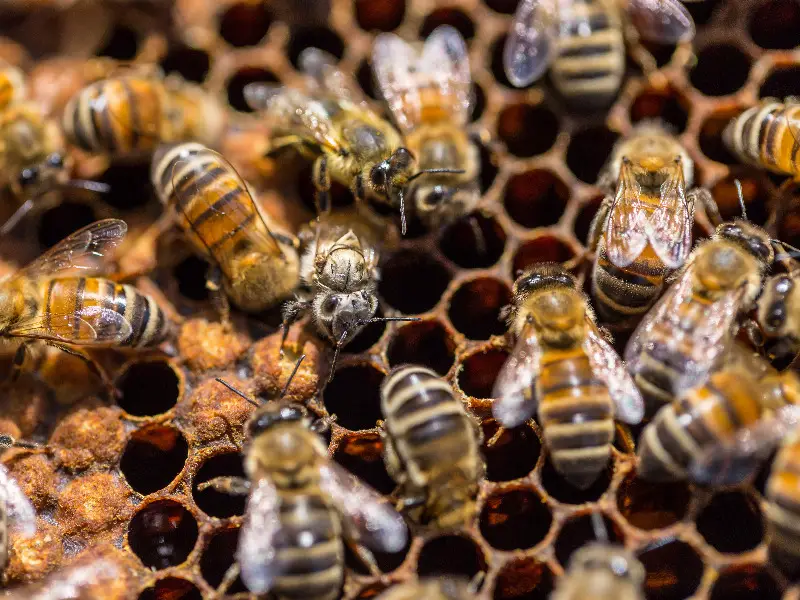
Reproduction of bees - the role of drones
Drones are the male members in a hive and their main role is to mate with the queen. Although they make up only a fraction of the population in a hive, they are central to the reproduction and genetic diversity of the colony. In this section, we address the mating of drones with the queen, their lifespan, and their importance to the hive.
Mating with the queen
The only raison d'être of drones is to mate with a queen. They follow special pheromones emitted by the queen and meet her at so-called drone gathering places. The act of mating is a final rush for the drones, because immediately after successful mating they die. The sperm they transfer is stored in the queen's spermatheca and used to fertilize future eggs.
Lifetime
The life span of the drones is quite short compared to the queen and workers, often only a few weeks to months. Once they have completed their only task, mating with the queen, they die. In preparation for winter, remaining drones are often banished from the hive, as they have no other functions and only consume resources.
Importance for the stick
Despite their short lifespan and limited function, drones are essential for the genetic pool and health of the bee colony. By mating with drones from other hives, the queen contributes to the genetic diversity and thus the resilience of the colony. While they are not involved in the daily tasks of the hive, their genetic contribution is invaluable for the future of the colony.
Reproduction of bees - the workers
Workers are the unsung heroes of the hive. Although they are not directly involved in reproduction, they play an essential role in the process. They ensure that the queen is in top condition, care for the brood, and thus indirectly contribute to the health and continuity of the colony. In this section we will look at the division of labor among the workers, how they create a new queen when needed, and the role of pheromones in the reproductive process.
Division of labor
There is a strict division of labor in the hive, which also affects reproduction. Some workers are specifically responsible for brood care. They feed the larvae, regulate the temperature in the brood chamber and ensure the cleanliness of the cells. Other workers are responsible for the care and feeding of the queen so that she can optimally perform her main task, egg laying.
Queen replacement
Should the queen die or lose her fertility, the workers have the ability to create a new queen. They select a young larva and feed it royal jelly, a substance that promotes the development of the larva's reproductive organs. The larva is grown in a special, larger cell and develops into a new queen that continues the reproductive cycle.
Pheromones
Pheromones play a crucial role in hive communication and are especially important for reproduction. The queen emits special pheromones that stimulate the reproductive drive of the drones and signal to the workers that she is still fertile. Should these pheromones weaken or become absent, this often initiates the process of creating a new queen.
Reproduction of bees - The mating flight
The mating flight is one of the most impressive and critical events in the life of a queen bee. This unique flight lays the foundation for the reproduction of the entire colony and has a significant impact on its genetic diversity. We take a look at the process of the mating flight, the place where it takes place, and the ideal time for it.
Procedure
The mating flight begins when the young queen leaves the hive, often accompanied by a small group of workers. Once she reaches the drone collection site, she mates with several drones. Any drone that successfully copulates with the queen dies shortly thereafter. The collected sperm is stored in the queen's spermatheca and is used to fertilize eggs for the rest of her life.
Location
Mating takes place in the air at special drone gathering sites. These sites are often several kilometers from the home hive and attract drones from different hives. The physical distance minimizes the likelihood of inbreeding and promotes the genetic diversity of the colony.
Time
The timing of the mating flight depends on several factors, including weather conditions and the age of the queen. Ideally, the flight takes place on a warm, sunny and windless day. Young queens usually undertake their mating flight a few days to a week after they have hatched.
The mating flight is a crucial moment in the reproductive cycle of bees and is influenced by many variables. Its successful execution ensures the long-term health and genetic diversity of the bee colony.
Reproduction of bees - egg laying and larval development
Egg laying and subsequent larval development are crucial steps in the bees' reproductive process. The queen and workers work hand in hand to create optimal conditions for the development of the next generation. In this section, we discuss the egg-laying process, brood care, and the different larval stages that are passed through on the way to a fully developed bee.
Egg-laying process
The queen is the only member in the hive that can lay eggs. She fertilizes the eggs with sperm from her spermatheca before placing them in the honeycomb cells. A single egg is placed in the center of each cell. Depending on the needs of the colony and the season, the queen can lay up to 2,000 eggs per day.
Brood care
Brood care is mainly performed by the workers. They feed the larvae, keep the brood chamber clean and regulate the temperature to create ideal conditions for larval development. Nutritious substances such as royal jelly or pollen are used for feeding. Interestingly, royal jelly is only fed to the larvae that are to develop into queens.
Larval stages
After the eggs are fertilized, they go through several stages of development. First, they hatch as larvae and are fed several times during the larval stage. Then pupation takes place. At this stage, the characteristic features of a bee, such as wings, legs and the stinger, form. Finally, the young bee hatches and becomes part of the working community in the hive.
Reproduction of bees, why swarming?
Swarming is a natural form of reproduction for bee colonies and one of the most impressive behaviors in the animal world. It is a key event not only for dispersal but also for genetic diversity. In this section, we highlight the reasons for swarming, the preparations that are made for it, and the actual process of swarming.
Reasons for swarming
There are several reasons why a bee colony swarms. One of the main reasons is overpopulation in the hive. When the hive contains too many bees and resources become scarce, the colony often decides to swarm. Other reasons can be a weak or old queen that is no longer able to lay enough eggs, or suboptimal conditions in the hive such as excessive humidity or disease.
Preparations
Before a bee colony swarms, intensive preparations are made. Several so-called "swarm cells" are built, in which new queens are raised. The old queen is put on a diet by the worker bees so that she becomes able to fly. In parallel, the "trace bees" begin to scout out suitable locations for the new hive.
Procedure
The actual swarming process is a well-orchestrated spectacle. A part of the workers and the old queen leave the hive together. They first gather in a nearby place, such as a tree or a group of shrubs. From there, they send out tracker bees that search for a suitable location for the new hive. Once a suitable place is found, the swarm flies there and starts building the new hive.
Reproduction of bees in different seasons
The seasons have a decisive influence on the reproductive activities of bee colonies. Both environmental conditions such as temperature and food availability and the internal biological rhythms of bees play a role. In this section, we look at the peculiarities of reproduction in spring, summer and autumn.
Spring
Spring is the most active phase of reproduction for most bee colonies. The queen begins to lay eggs intensively to quickly increase the population of the hive. The increased activity of flowering plants provides abundant food in the form of nectar and pollen. Egg laying and larval development are at their peak during this phase, and the risk of swarm formation is also greatest.
Summer
In summer, the bees' reproductive activity usually reduces a bit. Although there is plenty of food, conditions are often extreme, such as high temperatures, which can put a strain on the hive. The queen lays fewer eggs and the main focus is on gathering food for the coming cooler months.
Fall
In autumn, bee colonies prepare for the upcoming winter. Reproduction is at its lowest during this phase. The queen significantly reduces egg laying, and the workers focus on storing honey and pollen. Swarming is rare, as preparation for winter takes priority.
Reproduction of bees - threats and challenges
Although bees are incredibly adaptable and efficient in their reproduction, they face a number of threats and challenges. These can not only affect the ability of bee colonies to reproduce, but also the survival of the colony as a whole. In this section, we take a look at the impact of parasites, climate change and pesticides on bee reproduction.
Parasites
The varroa mite is one of the most dangerous parasites for bee colonies. It attacks both adult bees and larvae and can significantly reduce the reproduction rate. In addition, varroa infestation can weaken the bees' immune system, making them more susceptible to disease.
Climate change
Climate change has far-reaching effects on bee reproduction. Changing weather conditions and seasons can reduce the food supply and disrupt the bees' life cycle. The period of egg laying and larval development is particularly affected, as these phases are highly temperature-dependent.
Pesticides
The use of pesticides in agriculture is another major challenge. Many pesticides are toxic to bees and can affect the reproductive ability of the queen. The death of workers responsible for brood care can also negatively affect larval development.
Conclusion: reproduction of bees
After an in-depth examination of the complex and fascinating topic of bee reproduction, we now come to the conclusion of this article. In this conclusion, we would like to summarize the knowledge gained and give an outlook on the importance of this topic for humans and nature.
Summary of the findings
Bee reproduction is a multi-faceted subject, ranging from the biology of the individual to the dynamics of the entire colony. The role of the queen, the workers and the drones in reproduction, the different seasons and their effects, as well as the threats and challenges show the complexity and fragility of this natural process.
Significance for man and nature
Bees play a crucial role in ecology and are indispensable for pollinating many of the plants we feed on. Understanding the mechanisms of their reproduction can not only help us protect bee colonies more effectively, but also has a direct impact on agriculture and ultimately on the food supply for humans.
Reproduction of bees an outlook
Given the current threats mainly from parasites, climate change and pesticides, further research in the field of bee biology and reproduction is urgently needed. Only in this way can we develop sustainable strategies to ensure the health and survival of bee colonies and thus make an important contribution to the preservation of biodiversity.
Author

-
Garden animal - A life with nature
Welcome to my animal blog! My name is Dirk and I am happy to take you on my journey through the fascinating world of animals and gardening.
Born 54 years ago, I have had an insatiable curiosity for the animal world around me since childhood. Although I have moved professionally in other industries, my true passion has always been animals and nature. It is remarkable how a small garden has become such an important part of my life.
Many of my fondest memories are associated with the animals that share our home. Whether it's the curious squirrels that scurry across the trees in the morning, the colorful variety of birds that visit our feeders, or the busy bees and butterflies that pollinate our flowers, every moment with them is invaluable to me.
This blog is my contribution to share my experiences, discoveries and insights with like-minded people. Here I will share stories of unforgettable encounters with animals, give tips on gardening and creating wildlife-friendly habitats, and take you on my journeys through nature.
Thank you so much for being here!
Cordial,
Dirk aka garden animal
Last posts
- 27. February 2024PetsVeganes Hundefutter – Grün und Gesund?
- 18. January 2024ChickensOregano für Hühner
- November 27, 2023HamsterDiurnal hamsters
- November 24, 2023HamsterHamster hammock

